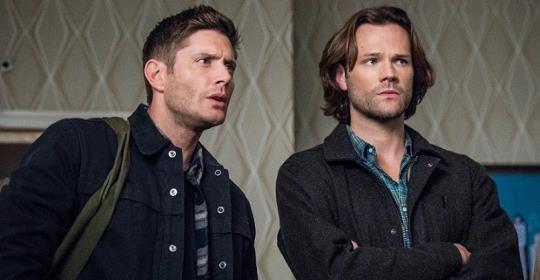Silver Screenings: The Three Episode Rule

My schedule was unfortunately less conducive to anime or television viewing this week. I only got to watch a few episodes of KADO: The Right Answer with my brother, which is not enough to really have something noteworthy to say.
However, it did incite me to think a bit on the “three episode rule” that is discussed in anime viewing fandom. It actually seems specific to anime fandom, as I can find no discussions of it in regards to Western television. No one says they give a show three episodes on Netflix before deciding if it is worth watching.
I imagine this is in part due to the length of the episodes. A Western television show has roughly twice the amount of time in which to work, meaning you can get a better feel for the characters and story in one episode. Were Supernatural an anime – I mean, in an alternate universe, not as as a nifty side thing – the first episode likely would not have ended with Sam joining Dean on his cross-country trek to find their father. That single episode would have been the first “arc”, and perhaps stretched out to be the first three episodes total.
Of course, the goals of those first episodes are completely different. Like many episodic Western shows, Supernatural must use its first episode to not only establish characters and long-term motivations, but it must also give the viewer – and more specifically, the network executives – an idea of what to expect each week. Every episode will feature Sam and Dean in a new town, meeting new characters to figure which supernatural creature is wreaking havoc.
There are some anime that reflect this same episodic narrative. Sailor Moon is perhaps one of the more notorious older examples, where one of Queen Beryl’s henchmen would regularly send a monster out to capture the energy of Tokyo’s citizens. Tetsuro visits a multitude of worlds and sees many adventures in Galaxy Express 999, with the overall plot being fed piecemeal to the viewer over time.
More often than not, such episodic series are the exception to the rule. Most shows are instead divided more closely into chapters akin to a book. As these series typically have a planned beginning, middle, and end, each episode in some way focuses on pushing that narrative forward rather than an easily syndicated pulpy adventure. Supernatural’s concept and adventures must work as a rerun on TNT as well as it does a binged show on Netflix or DVD.
Modern television is beginning to change. The first seasons of Daredevil and Jessica Jones are perfect examples of Western shows plotted out with each episode designed to push towards a specific endpoint. Game of Thrones follows the structure of the books it is based on.
Even so, those forty-five minutes per episode is enough to inform a viewer if they’d like to watch a show or not.

“We’ve been recycling the same character arcs for HOW LONG now?”
So what about anime? Is it simply that it cannot fit enough material into a single episode?
Well, let’s take the first episode of Darling in the Franxx. It introduces a group of characters and conflicts in the first episode, as well as a potential weekly hook. “Every episode a monster shows up, and protagonists Hiro and Zero Two team up to defeat the beast together”. Theoretically it does everything that Supernatural does in its first episode. We get each character’s motivations and a hook.
The second episode leaves the hook dangling by removing the monsters of the setting from its core conflict. That chapter instead takes a deeper look at the inner conflict Hiro is struggling with and how it impacts his standing with the others.
This is completely different to Western television writing. In the second episode of Supernatural you’re more likely to have Sam behaving like a sullen jerk most of the episode. Dean will confront him at the mid-point and in the episode’s closing the two will make mild progress. As the show is too busy with its monster-of-the-week plot, it will barely address the inner turmoil waging war inside of Sam’s spirit.
The first and second episodes of Supernatural are tonally consistent, but the first two episodes of Darling in the Franxx feel very different from one another. They’re part of the same story, but you don’t yet know what to expect in the future.
As such, the three-episode-rule gives you a wider sampling to determine what to expect from the show in the long-term. For me, Darling in the Franxx is a show using the pairing of its pilots to bluntly create metaphors for the sexual awakening of teenagers. A topic no doubt uncomfortable to some while dismissed as fan-service by others, I find it an opportunity to examine how interpersonal relationships between male and female are impacted not just physically, but emotionally and intellectually once sex is in the picture. None of the characters are actually engaging in sex, but the metaphor is as in-your-face as a Hawaiian Punch.
I knew I wanted to watch the show after episode three not because of the robots punching monsters. It is because episode three ends in such a fashion that I expect these characters to be challenged and changed throughout the series. Whether the show will truly be good or not I have no knowledge. I’ve since kept myself blind and deaf to it as I’d like to watch it when it is complete.
In theory, Darling in the Franxx is a perfect example of what to expect of a show in three episodes. You get an introduction to the setting and characters while also getting a first taste of what the series plans in the long-term. Unfortunately, I feel that there are many who treat the rule much more closely to that of a Western pilot of a TV show. If you apply this rule to something like Food Wars! you don’t really get any sort of opening thesis statement. The first episode pretty thoroughly covers the tone being sought, and the second and third episodes merely introduce the conflicts Souma can expect in his new school as well as what friends he’ll have. By the third season, there hasn’t been much in the way of transformation.
I’ve read reactions to Darling in the Franxx that were disappointed in the first three episodes because they failed to have any impressive fights against monsters. I also read impressions that failed to grasp the unexpected conflicts and challenges each character would be having due to the sudden presence of Zero-Two. It felt as if the viewers were expecting a clear long-term tone to be established.

Let us disregard for a moment that these viewers are failing to apply any deeper readings of the shows they’re watching. Let us mildly address the difference in ambition Darling in the Franxx clearly has that Food Wars! lacks. If the three-episode-rule has any particular failure, it is that it cannot account for the Japanese structure of Jo-Ha-Kyū.
Trigun is not one of my favorite anime based on the adventures and comedy of the first three episodes. It is a favorite because of the break that comes halfway through, introducing a real challenge to its protagonist Vash the Stampede. It is at that point that the show goes from good to great. Its ambition becomes more than to entertain, but to stir the viewer, be it by their thoughts, their emotions, or both.
Due to the longer narrative of Food Wars!, it is possible that break is only now coming in the third season. The status quo at the school has been disrupted and, at the mid-season finale, Nakiri has uncovered a perception changing revelation. Whether this actually challenges the characters or not is to be seen. All perceived challenges could be superficial, as is often the case in long-running shonen franchises.
Even so, this sort of break in status quo cannot be foreseen in three consistent episodes.
This means the three-episode-rule is not enough to determine if a show is truly good or not. This is why I had unsubscribed from Anime Elimination on YouTube. I had appreciated the higher standards after witnessing the undying love many modern fans seem to have for anything and everything, but the reviews grew to twist the purpose of the three-episode-rule. They were critical analyses on as few episodes as possible, and even mundane looking shows weren’t given a fair pass.
At the end of the day, the three-episode-rule doesn’t exist to inform you if the show is going to be good or not. It exists to determine if you will be entertained or not. This is a highly subjective response exclusive to your personal tastes.
For me, the three-episode-rule is useful in determining what is more worthy of my time. I had begun the Record of Lodoss TV series just before Slayers, yet it was Slayers that appealed to me more. There’s a variety of reasons for that – and on second thought maybe I should have detailed some of that instead of this naval-gazing piece – but at the end of the day the characters, writing, and direction of Slayers appealed to me more.
Right now, I’ve watched enough of KADO: The Right Answer to know that the show will appeal to me. It’s not concerned with flashy action sequences. It’s more interested in taking a simple concept and exploring it in a deeper dimension. Will it succeed at that? I don’t know.
I don’t know and that’s okay. The three-episode-rule doesn’t exist to determine whether a show is good or not. It is not a critical method. It is a personal method to determine the most basic and superficial of evaluations: am I entertained?
Now, Darling in the Franxx is exciting to me because I see promise of intellectual stimulation. Despite obvious metaphors I feel the anime will reward a deeper reading and perhaps repeated viewings. However, I cannot possibly know that without first watching the series in its entirety.
Until then, all I know is that the first three episodes entertained me more than many shows over the past year or two.
“I was entertained” and “it was good or great” are two very separate ideas, and it is very important that viewers become more discerning between the two if they’re going to insist on discussing and using the three-episode-rule.


